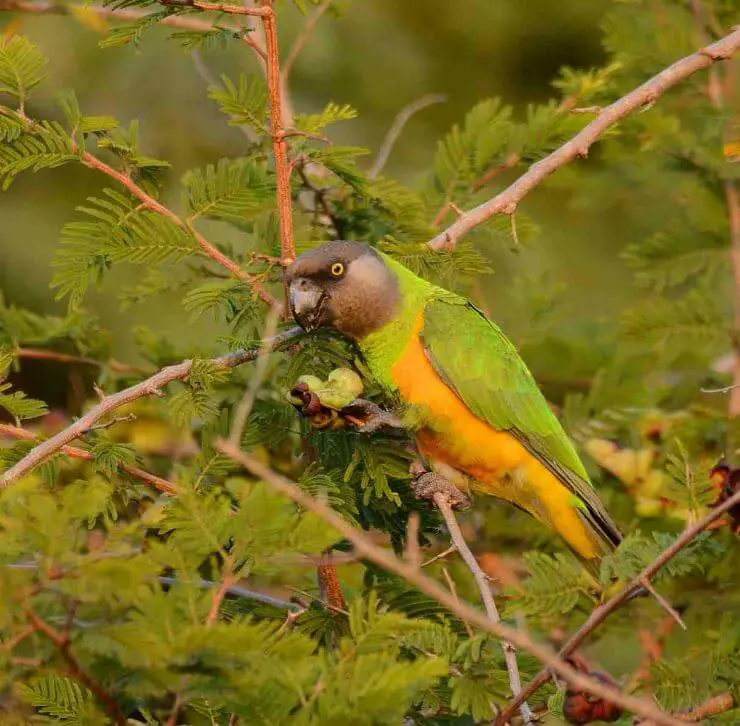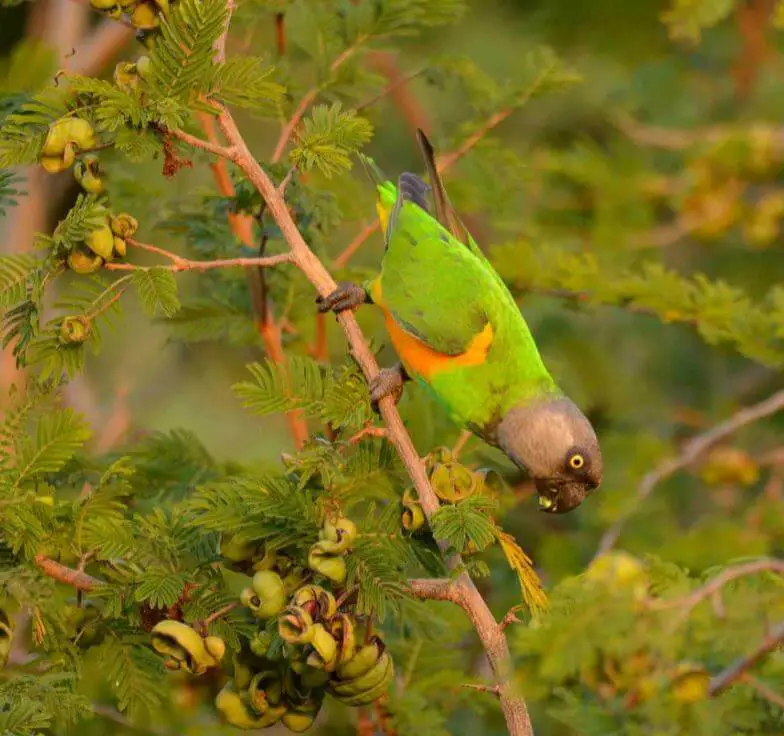
Senegal Parrot 23 cm; 120–161 g. Head grey; upperparts, breast, and thighs green; belly yellow, shading to orange in the center; tail greenish-brown; underwing-coverts yellow.
Immature duller, with a brownish head. All-yellow morphs reported the Gambia. Race versteri darker above, with deeper orange on the center of the breast and upper belly.
Systematics History
Editor’s Note: This article requires further editing work to merge existing content into the appropriate Subspecies sections. Please bear with us while this update takes place.
Proposed race mesotypus (from the E end of the range) appears indistinguishable from, or only a clinal extreme of, nominate race. Two subspecies are normally recognized.
Subspecies
Poicephalus senegalus senegalus Scientific name definitions
Distribution
Poicephalus senegalus versteri Scientific name definitions
Distribution
Distribution
Editor’s Note: Additional distribution information for this taxon can be found in the ‘Subspecies’ article above. In the future, we will develop a range-wide distribution article.
Senegal Parrot Habitat
Any type of lowland savanna, but apparently favoring relatively open country with Adansonia or Parkia filicide numerous, apparently also areas with Borassus palms.
Open woodland and cleared agricultural land with scattered trees, light orchard bush, or isolated patches of heavier, almost closed-canopy woodland and wooded valleys; also in villages.
Movement
Sedentary in places, e.g. Burkina Faso, but noted more numerous in the rainy season, SW Niger, and a rainy season visitor (Sept-Dec) to parts of S Mauritania. Also seasonal, Apr-Dec, N Ghana, i.e. avoiding driest period.
Senegal Parrot Personality
You will enjoy watching this playful and fun parrot perform its acrobatics inside or outside its cage. Always in a good mood, he is sensitive to the point of depression if his master is often absent or does not devote enough time to him.
In this case, it may stop feeding or tear its feathers (pecking). It is advisable to spend at least one hour in the morning and one hour in the afternoon with him.
If the Senegal Parrot is not one of the most talkative species, you can still teach it a few words that it will enjoy repeating. Very endearing and sociable, it is tamed by being regularly handled.
The Senegal parrot tends to trust only its owner and it is difficult for the rest of the family to get close to it. By accustoming him very early to different people, he can lower his guard.
Senegal Parrot Diet
Fruits of Ficus, Adansonia, Ximenia Americana, and Pterocarpus Erinaceus, seeds of Parkia, Acacia albida, Khaya senegalensis, Vitex Bienkowski, Butyrospermum parkii, and Sclerocarya diarrhea, young buds of Cassia, flowers of Melina, plus cultivated crops such as millet, maize, and peanuts.
Senegal Parrot Sounds
Calls include a variety of piercing or grating screeches, typically rather drawn-out and thus much longer than most congenerics. Calls range from a rather high-pitched “krrreeeh” to much lower-pitched and more subdued nasal notes.
Senegal Parrot Breeding
Jan–Oct in the Gambia; Jun in Ghana; Aug in Niger; bird noted entering tree-hole in Nov, Burkina Faso; eggs and young fledging in Oct, Nigeria.
Nest in hole commonly in larger branches of Adansonia or Parkia. Eggs 2–4, size 29·4 mm × 26·4 mm; incubation c. 25 days; fledging in c. 9 weeks.
Senegal Parrot for adoption
SOURCE: Parrot Wizard
Senegal Parrot Care
Originally from sunny countries, Senegal Parrot must evolve in a bright environment without however receiving direct sunlight (do not place its cage behind a window). While the temperature doesn’t need to equal that of its natural habitat, it does need to remain stable.
The bird – which has fragile lungs – must live in an airy room that is free from drafts. Keep it away from ventilation devices, air conditioners, and heaters.
Humidity promotes the development of respiratory diseases, as such, avoid places with high humidity such as the kitchen and the bathroom where water vapor will be harmful to him. Keep it away from all types of toxic fumes: cigarette and cooking smoke, insecticide spray, aerosol, paint, nail polish…
Senegal Parrot Cage
The minimum dimensions of a cage for this medium-sized parrot are 80 cm (length and height and 50 cm for the depth). But the bird will not disdain a larger space!
The Senegal Parrot does not like to be near the ground, so do not hesitate to raise its habitat. In his aviary, place the essential accessories: feeder, drinker, and perch.
Also, remember to provide him with durable toys made of natural materials such as wood. The parrot likes company, so its cage should be located in a strategic place: frequented but without excessive comings and goings. To keep the Senegal Parrot in good health, its living space must be perfectly maintained.
Senegal Parrot in the wild
In the wild, the Senegal Parrot likes to live in small clans. With Madame, he forms a very close-knit couple who spends his time together. In the presence of a female, this characterful bird is rather dominant and territorial.
Very rooted in its habits, the Senegal parrot needs a regular rhythm and a stable environment. He sleeps from sunset to sunrise and rests for two hours in the afternoon.
It is up to his master to adapt to the rituals essential to his mental balance. As for many wild animals accustomed to living in freedom, captivity can become anxiety-provoking for the exotic bird. It is then a question of offering him the optimal living conditions to promote his well-being…
Senegal Parrot Lifespan
The Senegal Parrot lives in several countries in central and western Africa: Senegal, Nigeria, Mali, Togo, Côte d’Ivoire, and Chad. The species appreciates wooded and arid savannahs as well as baobab forests. The life expectancy of a Senegal Parrot can reach 30 years.
Senegal Parrot Price
The price of a Senegalese parrot starts at 300$
Conservation Status

Not globally threatened (Least Concern). CITES II. Often abundant. Common, Boucle du Baoulé Biosphere Reserve, Mali. Breeds in W National Park, Niger.
Common residents, Ghana and Nigeria, e.g. in the latter’s Folgore Game Reserve, although uncommon in Yankari Game Reserve and uncommon to frequent in Gashaka-Gumti Game Reserve (now National Park). Common in Bénoué Nord National Park, Cameroon.
Senegal Parrot as Pets
SOURCE: Love of Pets




















